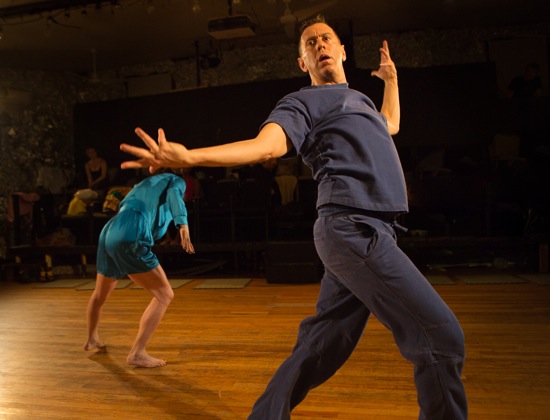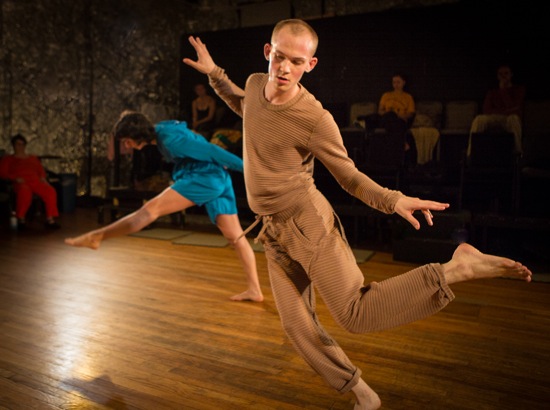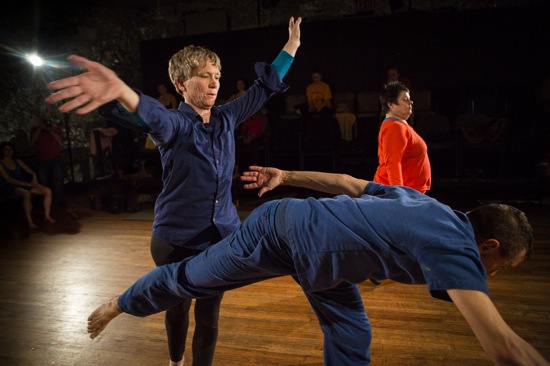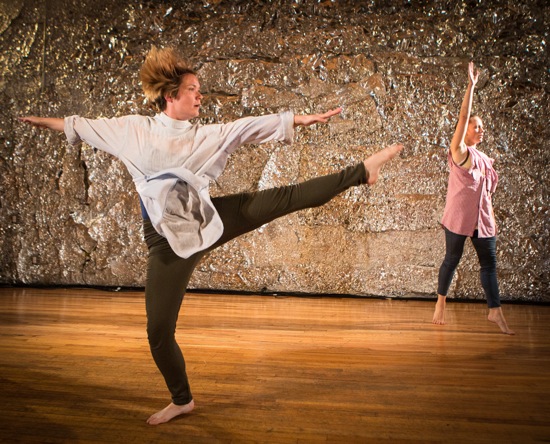
Rhea Speights (foreground) and Kyli Kleven in Jennifer Monson’s Folkdances for an Untidy Cardinal. Photo: Yi-Chun Wu
First time I’ve been to JACK, where Neil Greenberg, Yvonne Meier, and Jennifer Monson are sharing a program. The Brooklyn space reminds me of the original Dance Theater Workshop of the 1960s, when it sprang up in Jeff Duncan’s loft at 215 West 20th Street in Manhattan. Enough chairs for 50 or so spectators. Two small curtained dressing areas at one end. Two restrooms at the opposite end of the space (excellent for audience members, not so convenient for performers). I doubt that either bears the sign that was pasted to DTW’s single toilet closet: “Do not flush during the performance.”
JACK, however, is no white-walled loft. All but one of the walls (the free-standing one) are covered with aluminum foil that was put in place three years ago for a play; so far, no one has has had a better idea. Some of the variously shaped pieces of foil were crumpled furiously before being stretched out and applied. Others were handled in a more relaxed way and reveal hills and declivities. I enojoy looking at them. Maps of some mythical terrain, they respond to whatever color of light strikes them.
The program suits the funkiness of the space. For the first half of the performance, we sit in three rows arranged on the long side of the rectangle; for the second half, we first-rowers hike our chairs across the room and set up a new row over there. The performance thus acquires a different backdrop for both groups; we see the rest of the audience behind the dancers. But whatever the set-up, the performers don’t hesitate to come extremely close to us when the choreography demands it.
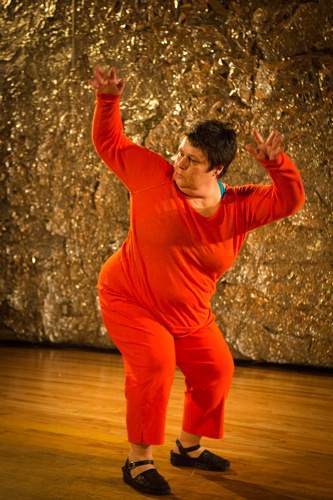
Yvonne Meier opening the program shared by Neil Greenberg and Jennifer Monson at JACK. Photo: Yi-Chun Wu
Meier begins with an untitled solo that may be an improvisation. Her partner is Chris Jager, who sits behind a drumset and keeps his eyes on her while wielding his sticks expertly and occasionally singing softly. Meier’s current onstage persona is that of a solid presence with a steely gaze; you wouldn’t want to run afoul of her. She sets a small movement jiggling and shaking through her body and builds it up in speed and spatial volume until it transforms into something else; meanwhile her black shoes are making only minimal advances along a path we can’t see. Every now and then, she kicks up a leg.
Her demeanor is thoughtful; swaying, gesturing with her arms, she seems to be testing possibilities. Jager stops drumming; she pauses a few minutes, then signals him to start again. He also plays a fine solo while she rests in an empty chair. Ben Demarest softens the lighting. “Slow down,” she tells him and dances a bit more. Then she counts down from seven, and when she’s done, he stops the music, and she walks out the door.
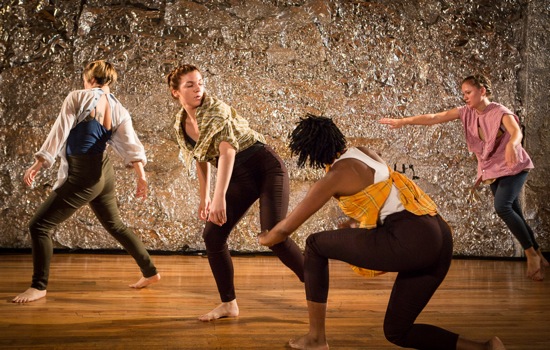
(L to R) Rhea Speights, Arielle Dykstra, Angie Pittman, and Kyli Kleven in Monson’s Folkdances for an Untidy Cardinal. Photo: Yi-Chun Wu
Monson’s Folkdances for an Untidy Cardinal is the biggest, most complex work on the program. I’m not sure I get the cardinal part (bird? Vatican prelate? cardinal as in number?). However, it is performed by four women, and they are purposefully untidy in certain ways, and folk dancing (of a sort) is what they do. I like it a lot.
Over their tight pants and leotards, Arielle Dykstra, Kyli Kleven, Angie Pittman, and Rhea Speights wear men’s shirts turned backward and stitched in ingenious ways. There’s no music but the sound of their feet, their breathing, and the strings of vowels and diphthongs they occasionally recite in lieu of singing. Trained dancers, they nevertheless move gawkily some of the time, wild in their individual bouts of dancing, even though their faces remain neutral.
Monson works with structures we associate with folk dance—partners facing each other, hand-in-hand chains, finger snaps, etc.— but rumples them. Dancers, paired spoon-fashion and holding both hands, advance as if they’re trying to make the most of the difficulties togetherness can engender. All four hold hands in a clump and try to walk without breaking their grips; they’re not in unison, they walk as if each were experiencing rocky terrain differently. Yet, interestingly, their differences are patterned; they can repeat a sequence of steps exactly, down to the last waver, and they can drop from individual pursuits into synchrony in an instant.
Sometimes they use their feet energetically: hop, leap, and so on. In the end they form a close circle, and each sweetly touches a cheek of the person to her right. Then they take the dance to the floor—splatting onto their bellies, heads together, legs spread, rolling, rising, and doing it again. They’re so serious, and their gazes are so intently on one another or a distant horizon that you can imagine a society in disarray. Their last move is to turn their backs on us and face the silver wall.
I begin to think everything that happens at this performance has a “let’s see if this works” air. Or “I wonder if I’m remembering correctly what this feels like.” Yet, as I’ve indicate, for all the improvisatory air, solid craft supports the dancing.
Greenberg calls his solo This Solo and links it to a trio, This d’Occasion (a study), by using the lying-down sequence with which he began the first to link it to the second. The spare music for This Solo is Steve Roden’s symbol/cymbal, and the composer’s dream sand accompanies Greenberg’s dance for Molly Lieber, Connor Voss, and himself. The James Kidd Studio’s costumes for the threesome come from Greenberg’s 2014 quartet This, for which This Solo constituted preliminary research.
The solo is full of non sequiturs. Greenberg, holding the legs of his blue trousers up, walks daintily in a spraddle (can you picture it?), as if afraid of getting the hems wet. Then he drops to the floor and, supine, slowly raises his legs, separates them, and lowers them, his cupped hands held up, their palms close to his face (the music issues soft, mechanical growls). Shortly, he decides to walk with big thudding steps, or he waggles his head goofily, or he takes off and gallops in a circle. He exits backward into the dressing room rocking his arms from side to side.
Watching him, I think, “Interesting!” and “What is he doing?’ (The answer to the last is, I think, “what he’s doing.”)
The trio has somewhat the same feel, perhaps because he and the dancers constructed it from videotaped improvisations. Lieber, Voss, and Greenberg make big, bold movements, as they pursue individual activities; then they walk to a new spot, look around as if to check whether everyone’s good to go, and embark on something else. You can admire Lieber’s dreamy stretches and deep lunges, also Voss’s supple dislocations of head, torso, and limbs (he brings renegade taffy to mind). Greenberg sits, huddled over, and Lieber places a foot on his back. No domination in mind. After a few seconds, they repeat the maneuver.
To end the evening on a collegial note, Meier, Monson, and Greenberg improvise briefly together. Danger enters the picture. Monson takes no prisoners—throwing herself to the floor against Greenberg’s leg and getting tangled around it. Later Greenberg will come up behind her and rest her chin on his head. All three are seriously nutty, gravely playful. Periodically a smart phone tinkles out a tune, and one of them makes an “it’s for you” gesture, as if an urgent message has come through. Each one who’s called peers at the little screen; maybe the phone is telling these talented people what to do next. Greenberg thinks about a can-can, maybe a gigue. He and Monson take wobbly steps together. Finally Meir says, “Let’s go,” and walks out of sight. Okay, that’s the end.

